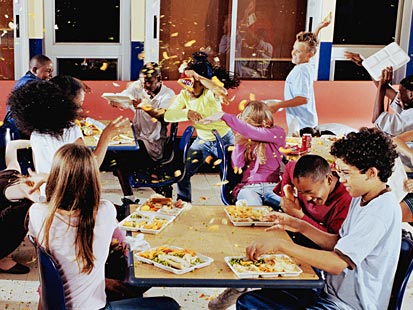Andrew Miller wrote about his four PBL pet peeves. I thought I would share mine:
Shifting to PBL and student-centered learning means that I give up all structure in my class and it turns into a “free for all.”
Of course teachers don’t actually say it like that. Instead I hear things like “how do I make sure that students learn all of the standards” or “in PBL teachers are ‘guides by the side’ so they don’t ever ‘teach'” or “how do I make sure that students are always ‘on task'” or “what if students choose not to learn about math (or whatever the subject is).”
Teachers in traditional settings are comfortable with control and order. They have standards to teach and a textbook to use. Many even have district mandated curriculum and pacing guides. All teachers have different comfort levels in the classroom as far as noise, order, and structure. For those teachers who are “type A” personalities, at first glance PBL is scary because it sounds like the teacher is losing control and students are taking over. While we do want students to take ownership of their learning, PBL is a framework for it to happen. By definition, a framework is a structure. PBL can be very structured (and I recommend a high degree of structure when first implementing and introducing it to students) or it can be looser to fit the style of any teacher.
Examples of the structures included in PBL include the entry event, driving question, and authentic audience. These are created by the teacher and frame where the project is headed. The teacher can decide which assessments will be formative and summative. The teacher also provides workshops when necessary and appropriate and can do them whole class or in small groups for differentiation. The teacher can also introduce other elements of inquiry into any project to bring up important ideas that students might “miss” on their own. Critical friends is an important structure for both teachers and students to provide feedback on their work.
When I first started using the PBL framework, I went very free and unstructured. My students were new to PBL and couldn’t handle it. They needed support. They came to me begging for it so I gave some structure to them that I gradually removed the rest of the year. Through this I learned that we need to ease kids into PBL and over time they will take more and more ownership and eventually tell you, “we got this, we don’t need facilitators to do this.”
In a nutshell, PBL is a structure for student centered inquiry, the opposite of a “free for all.”


I agree, Mike. PBL isn’t by any means a free for all, and the structure is important for successful student inquiry. My experience is similar to yours in that my students (6th graders) needed lots of structure throughout the process because it was new to them. As students become more comfortable with the process, they definitely can become more independent. That said, PBL does require that I give up a measure of control over the learning in my room. I had to adjust to that, but I think it was the best thing for my students. After all, in the end it’s really their learning, and they need to have greater control over it.